From left: the record warmouth, redear, and white crappie. IGFA
The term “panfish” dates back 200-plus years and simply refers to any fish that can fit into a pan. Depending on the size of your pan, that could be a pretty big fish. Today, the definition is a bit more specific, usually meaning a small, freshwater fish species cooked whole or filleted in a pan or skillet. Even the largest of some panfish species would still easily fit in the average skillet.
However, the individual fish we’re highlighting below are another story altogether. These are the true giants of the panfish world. So go find the biggest pan around, because we’ve rounded up the biggest panfish of all time, according to the “all-tackle records” recorded by the International Game Fish Association.
Bluegill: 4 pounds, 12 ounces
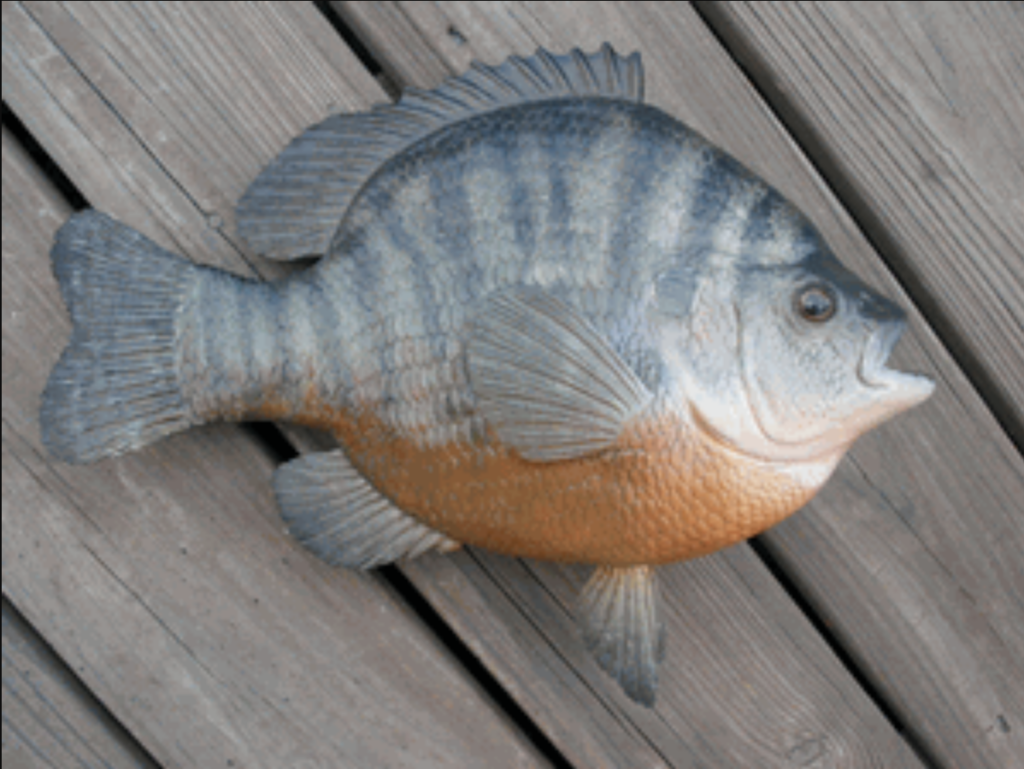
A replica of the world-record bluegill, which you can buy at thesharkstore.com thesharkstore.com
The current all-tackle bluegill record is held by T. Hudson, who caught a 4-pound 12-ounce fish on April 9, 1950 in Alabama’s Ketona Lakes. No other details about the catch are recorded by the IGFA, but subsequent stories say the fish was 15 inches long and had an incredible 18.25-inch girth.
Bluegills are found throughout much of North America and have even been introduced into Europe and South Africa. The second part of their Latin name, “macrochirus,” is Greek and means “large hand.” Pound-for-pound, they’re known as tenacious scrappers. A hand-sized bluegill on ultralight tackle will give even the most seasoned anglers a thrill.
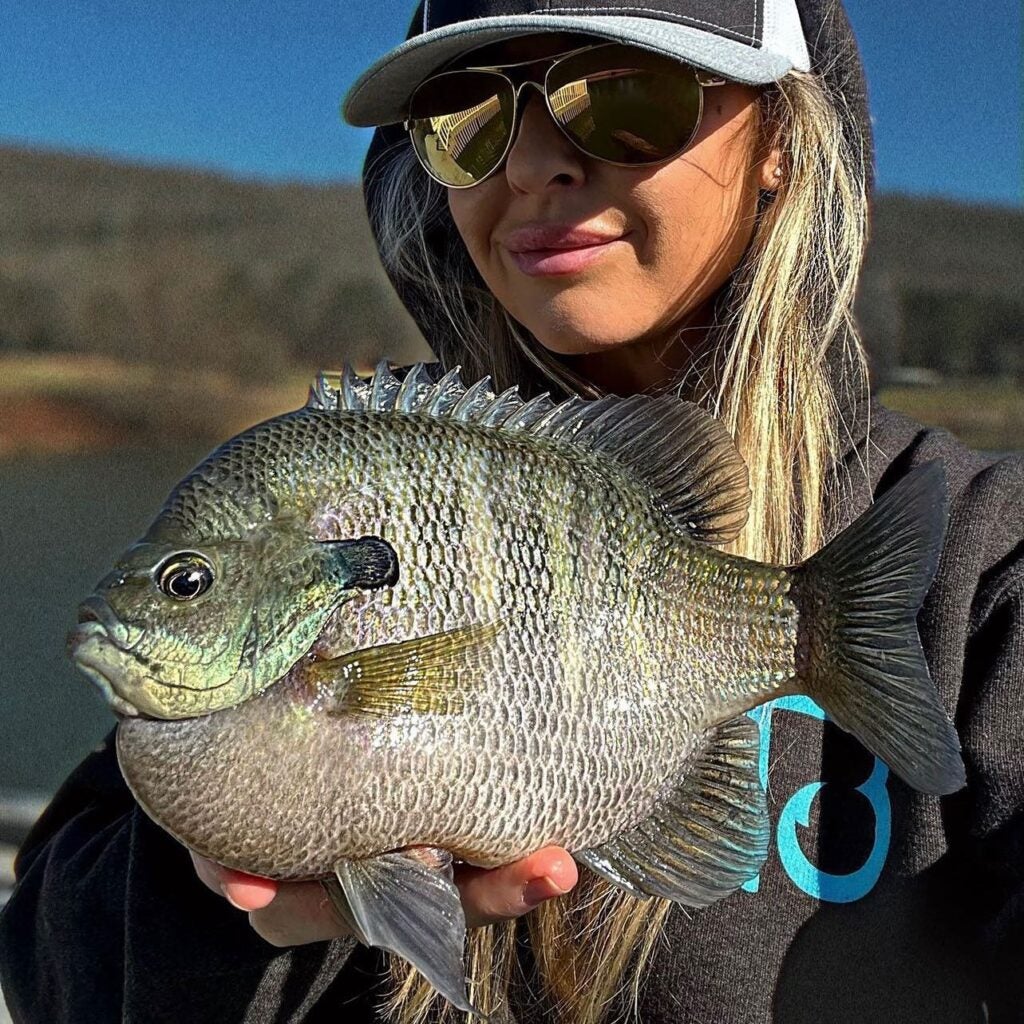
Sarah Parvin, also known as the “Slab Queen” Sarah Parvin
For reference on how giant T. Hudson’s bluegill actually was, above is a photo of Sarah Parvin, who is working with her dad to grow the next world-record bluegill. Her fish is a stud, but it doesn’t quite break the four-pound mark.
Black Crappie: 5 pounds, 7 ounces

IGFA
The all-tackle record for black crappie is a 5-pound, 7-ounce fish caught by Lionel Ferguson on May 15, 2018 in Tennessee’s Richeison Pond. The fish was 19.25 inches long with an 18-inch girth. Ferguson was using a Shakespeare rod and a Pflueger reel with 6-pound Zebco line. The fish was caught using a jig.
Sometimes referred to as papermouth, bachelor perch, specks, sac au lait, or calico bass, crappie are thought to be native to much of the eastern United States and southern Ontario. Like bluegill, they have been widely introduced into waters around the country and in other Canadian provinces. Members of the sunfish and black bass family, their somewhat roundish shape resembles sunfish. Their heads sometimes appear to shrink in proportion to their bodies, especially on the bigger slab fish. Their silvery bodies are covered in black spots, with the spots more pronounced on black crappie. White crappie spots appear neatly arranged. Black crappie spots are scattered irregularly. Spots aside, the way you tell them apart is their dorsal fins. White crappie have 6 spines in both the dorsal and anal fins, while black crappie have 7 or 8 spines in the dorsal fin.
White Crappie: 5 pounds, 3 ounces

The all-tackle world record crappie. IGFA
The All-Tackle record for white crappie is held by Fred Bright, who caught a 5-pound, 3-ounce fish at Enid Dam in Mississippi on July 31, 1957. The fish was 21 inches long, with a 19-inch girth. It was caught on an “Action” rod with a Denison Johnson reel spooled with Ashaway line.
Redear Sunfish: 6 pounds, 4 ounces
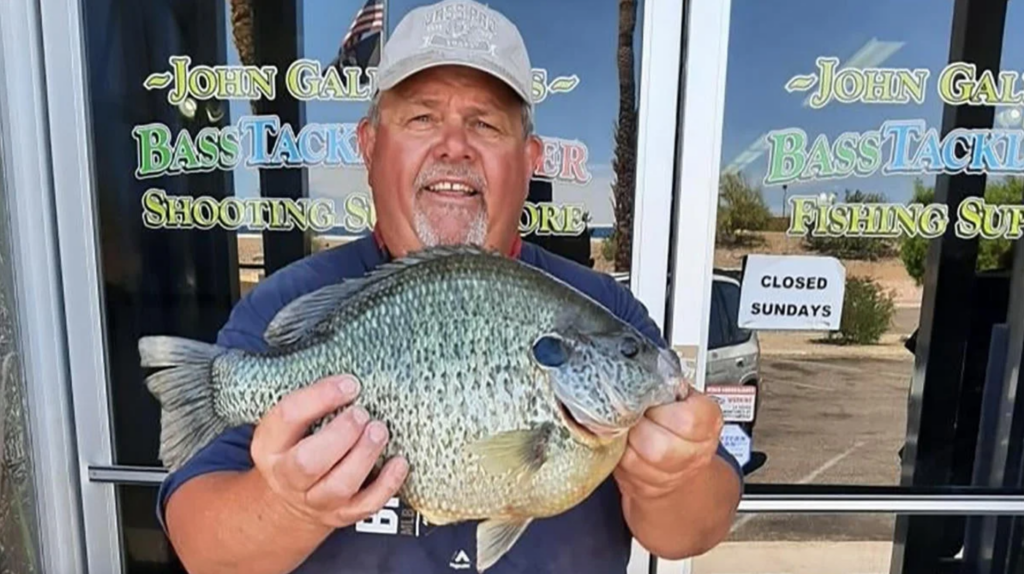
The all-tackle world record redear sunfish. Field & Stream
The all-tackle record redear sunfish is a beast of a panfish; a 6-pound, 4-ounce fish taken May 4, 2021 at Lake Havasu, Arizona, by Thomas M. Farchione. The fish measured 17 inches with a 20-inch girth. Farchione used a Lew’s combo and Berkley 6-pound line and a nightcrawler to catch the redear. Read the full story about Farchione’s record redear sunfish here.
Redears, originally found in Gulf states from Texas to Florida and up to Indiana and North Carolina, enjoy great favor as an introduced fish. Today, they’re found throughout the Great Lakes region and the West (where the current record was caught.) Redears can get big too. A one-pound sunfish of another species might make an angler take notice; redears in good habitat might reach 2 to 4 pounds or more. The typical, bright red edge to the black lobe on its semi-rigid gill flap is the fish’s signature feature. These colorful fish may also have vibrant green, yellow, orange, and black markings. Redears are more finicky eaters, preferring live baits such as worms, grubs, insects, and sometimes shrimp.
Flier: 1 pound, 5 ounces

Curt Brooks with his all-tackle world record flier. IGFA
There’s a three-way tie for the all-tackle Flier record, although one of the fish is recorded as being an ounce heavier. To set an IGFA World Record, an angler must beat the current record by at least 2-ounces.
Angler Twila Gates York has a 1-pound, 5-ounce flier recorded, caught May 9, 2015 in Jackson County, Florida. The fish measured 12 inches with a similar girth. Next is a 1-pound, 4-ounce flier caught by R. Snipes on August 24, 1988 at Little River, Spring Lake, North Carolina. The fish was 11 inches long with an 11-inch girth. Finally, Curt Brooks also recorded a 1-pound, 4-ounce flier that he caught on February 26, 1996 in Loundes County, Georgia. That 12-inch fish had an 11-inch girth.
Many people mistake fliers for other small sunfish. They average just a few inches in length and a few ounces in weight. The mature flier has the typical sunfish roundish body with coloration from a deep olive green to silver with interrupted rows of black spots along the side and a black gill cover. The large black teardrop-shaped marking below the eye identifies it as a flier. The flier has 11-13 dorsal fin spines. Catch them in warm waters with heavy vegetation, especially swamps, ponds, backwaters, sloughs, low-flowing streams and creeks, and roadside drainage ditches. The range is estimated to be much of the southern seaboard up to the Potomac River.
Green Sunfish: 2 pounds, 2 ounces
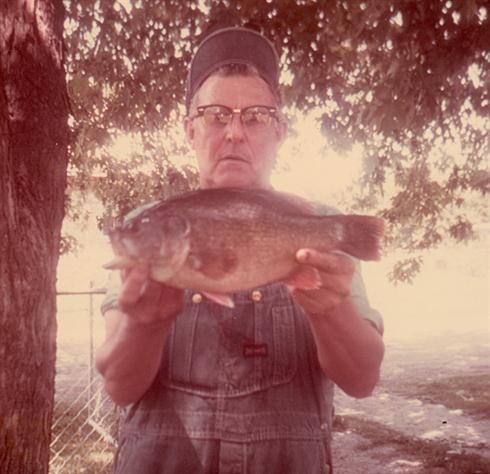
The all-tackle world record green sunfish. IGFA
The all-tackle green sunfish record is a 2-pound, 2-ounce fish caught at Stockton Lake, Missouri, on June 18, 1971 by Paul Dilley. The fish was 14.75 inches long with a 14-inch girth. Dilley used a Shakespeare rod and reel, spooled with 12-pound Trilene line. The fish slurped in a river worm.
Green sunfish are sometimes called green perch, sand bass, blue spotted sunfish or rubbertail. Plus, Arkansans sometimes refer to them as “slicks” if caught in a pond or “goggle-eye” if caught in a creek.
Whatever you call them, green sunfish are another prolific, tasty panfish. Native green sunfish are found throughout the eastern United States west of the Appalachians, and into the Plains States from North Dakota south, as well as Ontario, Canada, and northern Mexico. This fish is prized by anglers, especially kids, because it’s not a finicky eater, readily taking worms or other small live baits and lures.
Rock Bass: 3 pounds
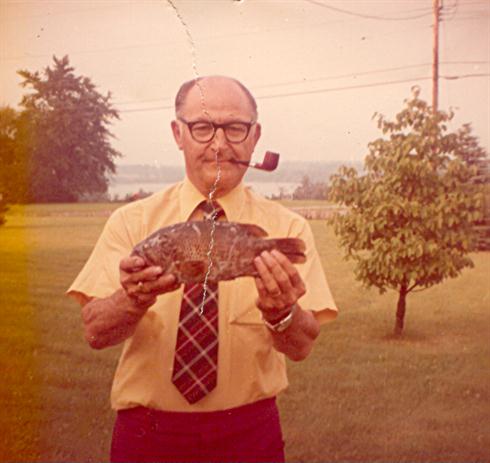
The all-tackle world record rock bass. IGFA
There is a tie for the all-tackle world record rock bass. Peter Gulgin caught a 3-pound rock bass on August 1, 1974 in the York River in Ontario, Canada. Gulgin’s rock bass was 13.5 inches long with an 11-inch girth. He caught the fish with a Zebco rod and reel, Shakespeare 10-pound line and a Mepps #2 spinner. Herbert Ratner, Jr. tied the record on June 18, 1998 with another 3-pound rock bass, this one caught in Lake Erie, Pennsylvania. Ratner’s fish was 16.25 inches long with a girth of 12 inches.
The rock bass is a red-eyed, aggressive fighting member of the sunfish family that’s brought a smile to many young anglers’ faces throughout the Northeast and Midwest. Rock bass have also been stocked in lakes around the country. They like cooler water with low turbidity and rocky bottoms, although they are sometimes found in weedier lakes and streams. Eddies in fast-flowing rivers can also hold these fish. Some say they look like a bluegill crossed with a black bass, due to the longer body and less-compressed build. Their mouths are considerably bigger than other sunfish. Rock bass are often confused with warmouth, but they can be differentiated by counting the number of spines in front of the soft rayed anal fin: a warmouth has three; a rock bass has six.
Warmouth: 2 pounds, 7 ounces
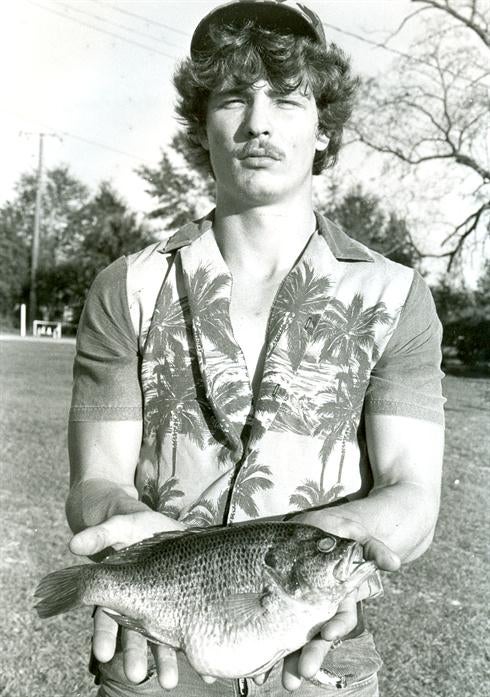
The world record all-tackle warmouth.
The all-tackle record warmouth weighed 2 pounds, 7 ounces and was caught on October 19, 1985 by Tony Dempsey at Guess Lake, Yellow River, Holt, Florida. Dempsey’s warmouth was 13.25 inches long, with a girth of 13 inches. He used a Garcia rod, Daiwa S-80 reel and 12-pound Stren line to entice the fish with a wiggler.
Also called stump knocker, goggle eye, and goggle-eyed perch, Warmouth are native to the Great Lakes and Mississippi River basins from western Pennsylvania to Minnesota and south to the Gulf of Mexico, the Atlantic and Gulf drainages from Rappahannock River in Virginia to Rio Grande in Texas and New Mexico. The fish have been stocked in Mexico and Puerto Rico. Warmouth like weed beds and soft, muddy bottoms, are frequently caught near stumps or heavy woody structure (hence the nickname stump knocker.) Unlike the similar-looking rock bass and most other species, it can tolerate turbid or muddy waters. Although it’s a good-tasting panfish that can be easy to catch with a variety of natural baits and artificial lures, it’s an underrated gamefish. One unique warmouth characteristic is teeth on their tongue, which helped the fish earn its formal name.
Pumpkinseed: 1 pound, 8 ounces
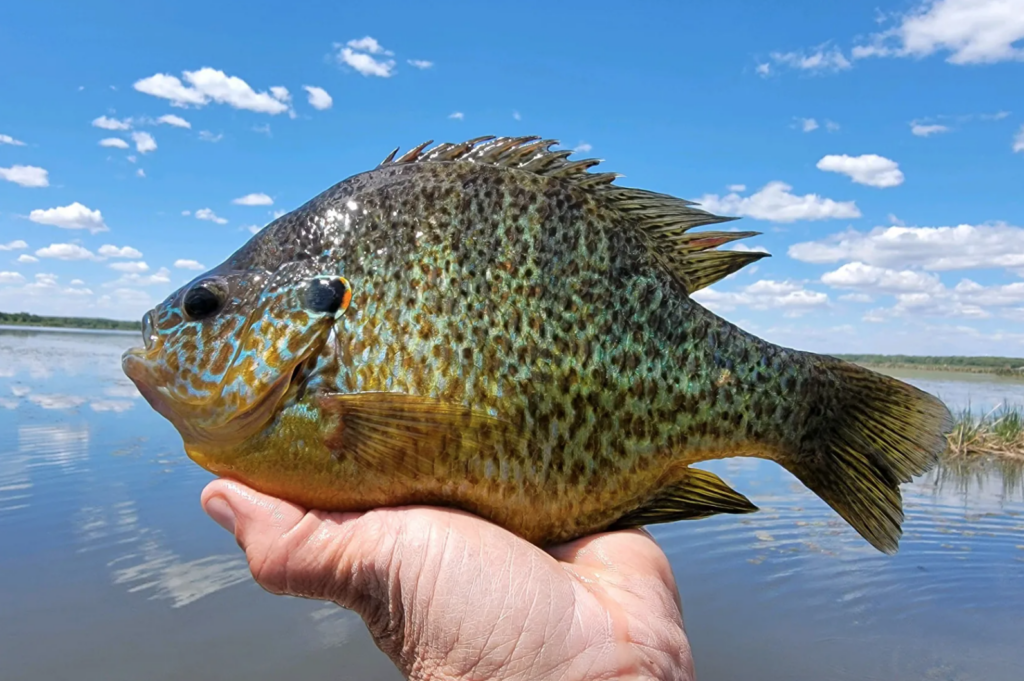
A giant Illinois pumpkinseed. Illinois Department of Natural Resources
The all-tackle record is help by Robert Warne with a 1-pound 8-ounce pumpkinseed, caught May 23, 2016 at Honeoye, New York. His fished measured 10.35 inches long with a 12-inch girth. Warne used an Abu Garcia rod and reel with 12-pound Hawgline. He caught the fish with a worm. There’s no available IGFA photo of Warne’s catch but pictured above you can see a 1.4-pound pumpkinseed, that was caught and released by the Illinois Department of Natural Resources at Hennepin-Hopper lakes during a survey.
Pumpkinseed inhabit Northeastern or Midwestern lakes and ponds with ample vegetation where they can hide from larger predatory fish such as pike or pickerel. Adult pumpkinseed can have broad shoulders on their disc-shaped bodies and, like bluegill, transfer that design into considerable power for a 1-pound fish. These exceptionally colorful fish have gill covers with a hard rear edge and the characteristic black lobe, often ending in a red half moon.
Redbreast Sunfish: 1 pound, 12 ounces

Redbreast sunfish illustration from the IGFA. IGFA
Alvin Buchanan is the redbreast sunfish all-tackle record holder, with a 1-pound, 12-ounce fish caught May 29, 1984 in Florida’s Suwannee River. The fish was 10.75 inches long with a girth of 14 inches. Buchanan used a Zebco rod and reel with 8-pound Trilene line to catch the sunfish on a mealworm. Unfortunately there’s no available IGFA photo of Buchanan’s catch.
Redbreasts are true native East Coasters, found from New Brunswick in Canada south to about central Florida. They are another popularly stocked species and have been introduced into other states and lakes in northern Italy. Aptly named, the belly or breast of the fish ranges from a bright yellow to orange red or crimson red.
Yellow Perch: 4 pounds, 3 ounces
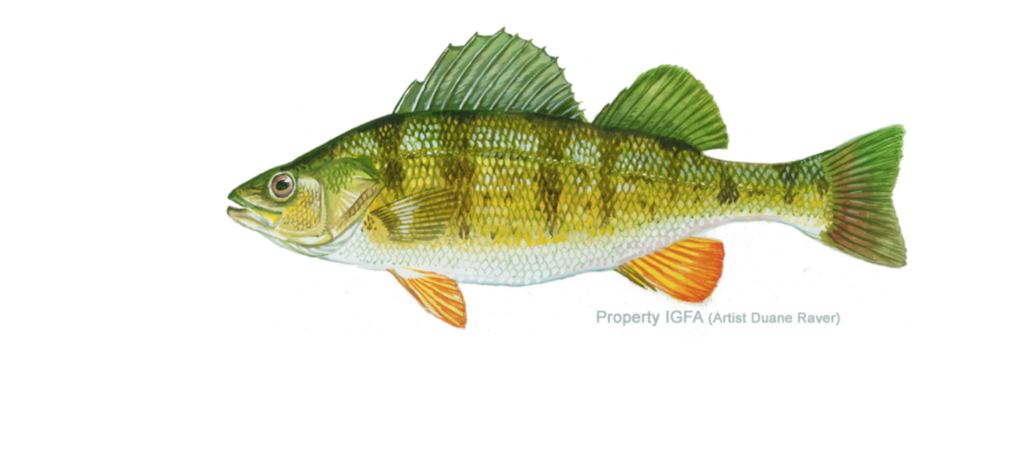
A yellow perch illustration from the IGFA. IGFA
The all-tackle record yellow perch is a 4-pound, 3-ounce fish caught May 1, 1865 in Bordentown, New Jersey by Dr. C. Abbott. There are no further details or photos available.
Yellow perch are among the most prized fish for eating, common throughout the northern United States and most of Canada. Yellow perch, unlike “white perch,” are true members of the perch family. They are distinctly colorful with a shimmering golden-yellow body and 6 to 8 black bands. Late winter fish in pre-spawn mode can have striking yellow-orange bellies. They are aggressive and readily take natural baits and small artificials, such as jigs and spinners.
Note: Record citations, physical fish characteristics, habitat, and bait preferences are derived from multiple sources, including the International Game Fish Association’s world records, www.takemefishing.org, and various state-maintained fisheries websites.
The post The Biggest Panfish of All Time appeared first on Outdoor Life.
By: Ken Perrotte
Title: The Biggest Panfish of All Time
Sourced From: www.outdoorlife.com/fishing/world-record-panfish/
Published Date: Tue, 19 Apr 2022 21:21:51 +0000
----------------------------------------------
Did you miss our previous article...
https://manstuffnews.com/weekend-warriors/how-to-clean-a-coyote-hide-in-your-washing-machine
 Backyard GrillingWeekend WarriorsAdvice from DadBeard GroomingTV Shows for Guys4x4 Off-Road CarsMens FashionSports NewsAncient Archeology World NewsPrivacy PolicyTerms And Conditions
Backyard GrillingWeekend WarriorsAdvice from DadBeard GroomingTV Shows for Guys4x4 Off-Road CarsMens FashionSports NewsAncient Archeology World NewsPrivacy PolicyTerms And Conditions
